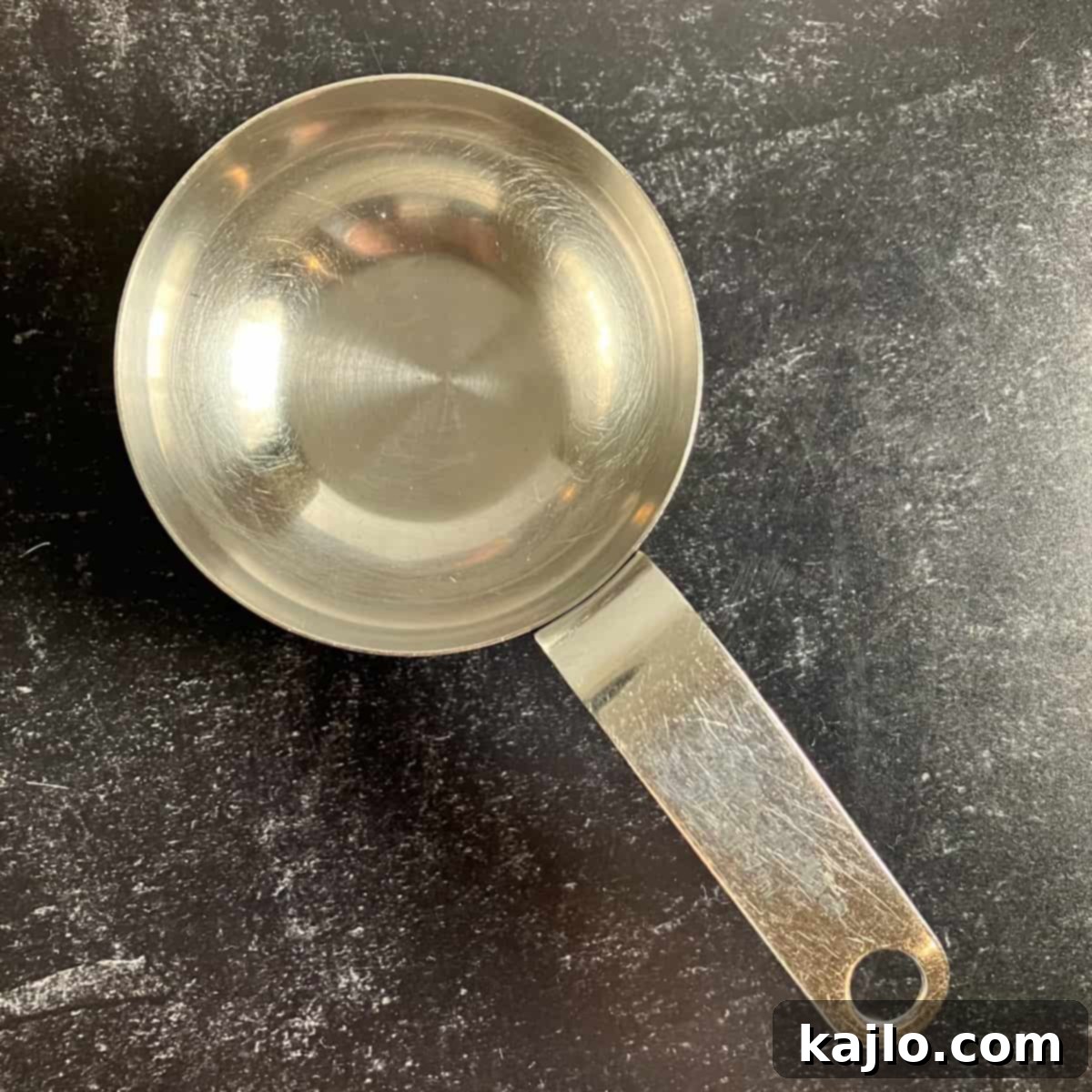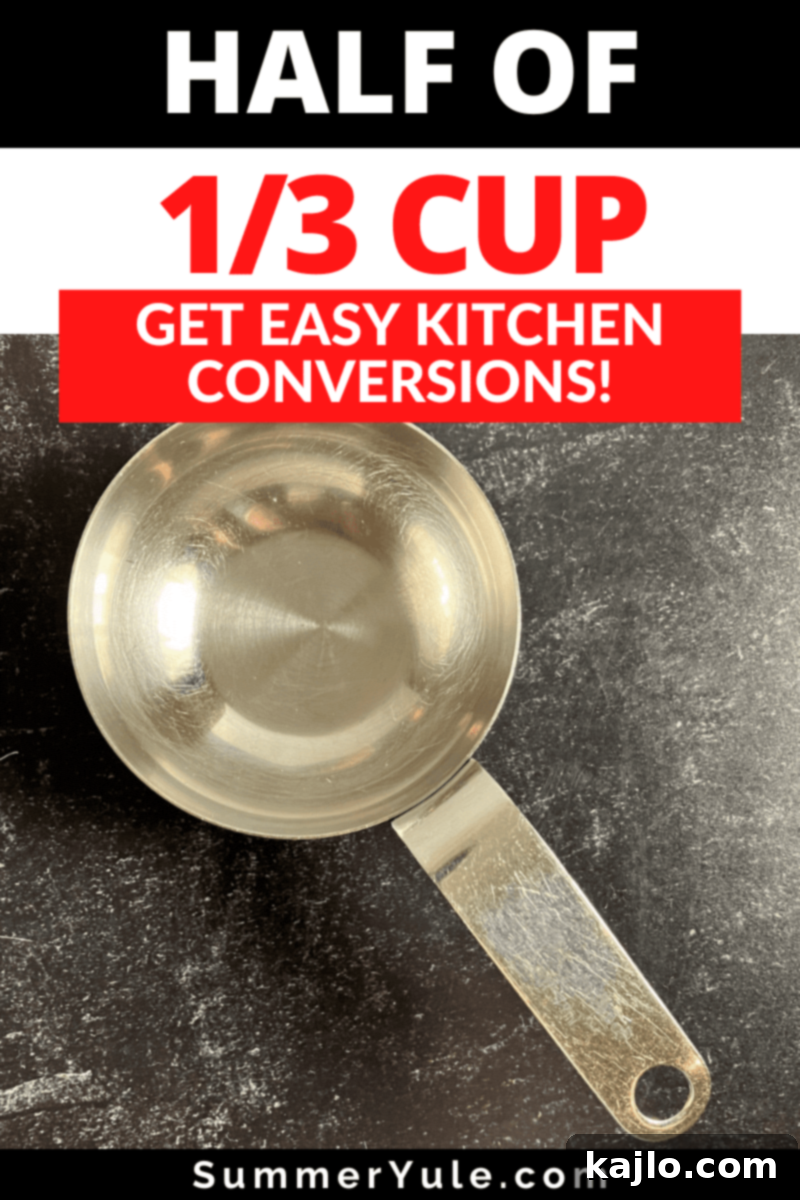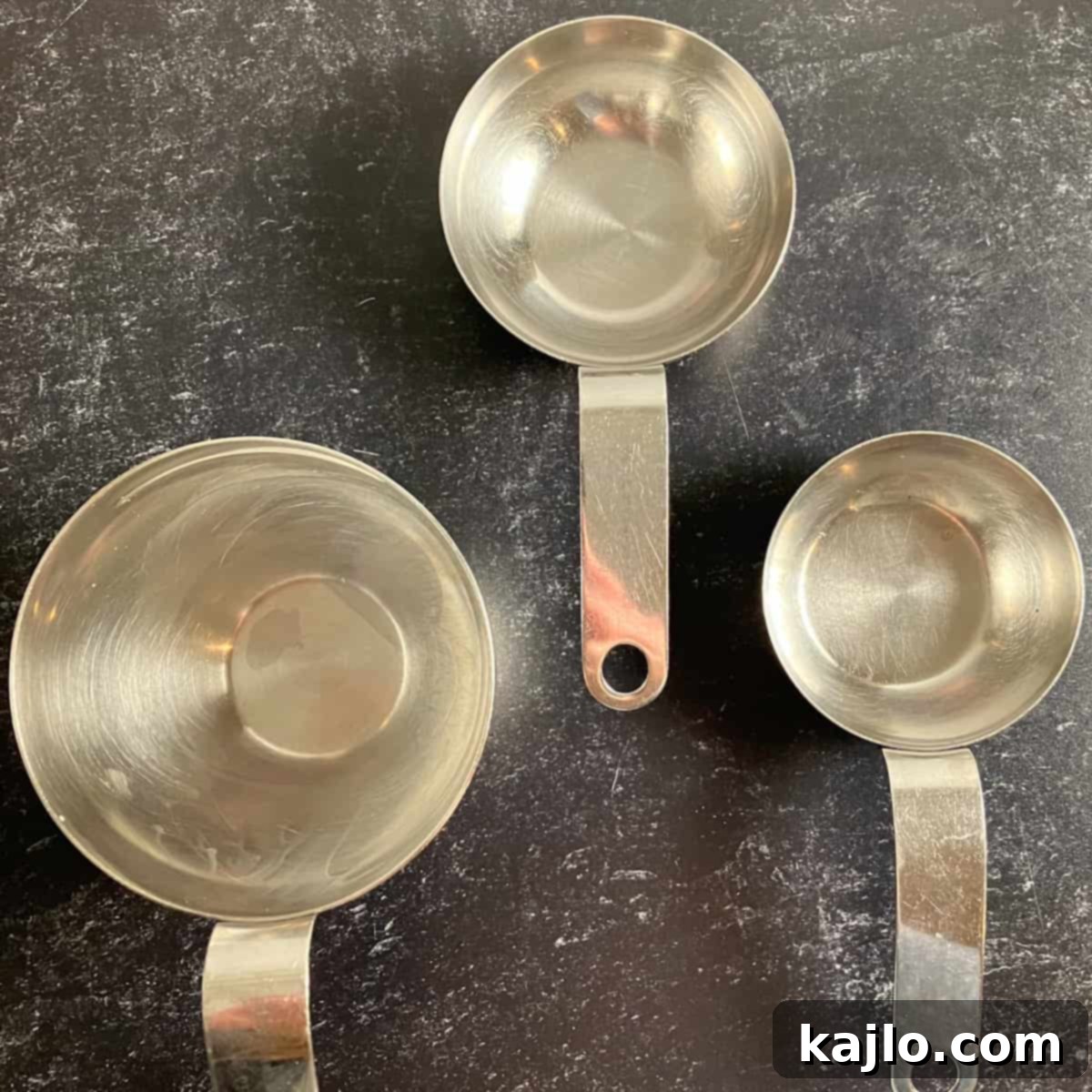Demystifying Half of 1/3 Cup: A Comprehensive Kitchen Conversion Guide
Ever found yourself needing to halve a recipe, only to be stumped by a measurement like “1/3 cup”? You’re certainly not alone! Precision in the kitchen, whether you’re baking a delicate cake or cooking a savory stew, can make all the difference in the final outcome. This comprehensive guide aims to demystify exactly what ‘half of 1/3 cup’ means, translating it into various practical units, and providing you with the confidence to tackle any recipe scaling challenge.
Knowing what is half of 1/3 cup is a fundamental skill for any home cook or baker. The straightforward answer is that ½ of 1/3 cup equals 2 2/3 tablespoons, which can also be expressed as 1/6 cup, 1 1/3 fluid ounces, or 8 teaspoons. To arrive at this, you’re essentially calculating 1/3 cup divided by 2. Mathematically, 1/3 is equivalent to 2/6, so half of a third cup logically becomes 1/6 of a cup. This knowledge is incredibly useful, particularly when adjusting recipes to suit smaller or larger servings.

Unlocking the Mystery: What is Half of 1/3 of a Cup?
When you need to measure precisely, having the right conversion at your fingertips can save time and prevent errors. Here’s the essential formula to remember for half 1/3 cup:
1/3 cup in half = 2 tablespoons plus 2 teaspoons
OR
Half of a third cup = 1/8 cup + 2 teaspoons
These practical equivalents are crucial for accurate recipe adjustments, especially when you don’t have a 1/6 cup measuring tool, which is not a common item in most kitchen sets. Understanding these breakdowns allows for flexible and confident cooking and baking.
Comprehensive Kitchen Conversion Chart: Halving, Thirding, and Fourthing Measurements
Scaling recipes often involves more than just halving. Sometimes you need a third or even a quarter of a specific measurement. Below is an expanded conversion chart designed to help you with various fractional measurements, making your cooking and baking journey smoother. This chart not only covers cutting 1/3 cup in half, in thirds, and in fourths but also includes many other common measurements you might encounter in recipes.
| Measurement | ½ Measurement | 1/3 Measurement | ¼ Measurement |
|---|---|---|---|
| 1 cup | ½ cup | 1/3 cup | ¼ cup |
| 7/8 cup | ¼ cup + 3 tablespoons | ¼ cup + 2 teaspoons | 3 tablespoons + 1.5 teaspoons |
| ¾ cup | ¼ cup + 2 tablespoons | ¼ cup | 3 tablespoons |
| 2/3 cup | 1/3 cup | 3 tablespoons + 1 2/3 teaspoons | 2 tablespoons + 2 teaspoons |
| 5/8 cup | ¼ cup + 1 tablespoon | 3 tablespoons + 1 teaspoon | 2.5 tablespoons |
| ½ cup | ¼ cup | 2 tablespoons + 2 teaspoons | 2 tablespoons |
| 3/8 cup | 3 tablespoons | 1/8 cup | 1.5 tablespoons |
| 1/3 cup | 2 tablespoons + 2 teaspoons | 1 tablespoon + 2 1/3 teaspoons | 1 tablespoon + 1 teaspoon |
| ¼ cup | 2 tablespoons | 1 tablespoon + 1 teaspoon | 1 tablespoon |
| 1/8 cup | 1 tablespoon | 2 teaspoons | ½ tablespoon |
| 1 tablespoon (tbsp) | 1 teaspoon | 1/3 teaspoon | ¼ teaspoon |
| 1 teaspoon (tsp) | ½ teaspoon | 1/3 teaspoon | ¼ teaspoon |
| ¾ teaspoon | 3/8 teaspoon | ¼ teaspoon | 3/16 teaspoon |
| ½ teaspoon | ¼ teaspoon | 1/6 teaspoon | 1/8 teaspoon |
| ¼ teaspoon | 1/8 teaspoon | 1/12 teaspoon | 1/16 teaspoon |
It’s worth noting that for some of the smaller measurements listed, such as 1/12 or 1/16 of a teaspoon, exact precision can be challenging. In these cases, it’s often acceptable to estimate with a “pinch,” “dash,” “scant ¼ tsp,” or “scant 1/8 tsp” of ingredients, depending on the nature of the recipe and ingredient.
What is Half of 1/3 Cup in Tablespoons? Detailed Calculation
Understanding the conversion of cups to tablespoons is fundamental for smaller measurements. To figure out what is half of 1/3 cup in tablespoons, we first need to establish how many tablespoons are in 1/3 cup. There are 16 tablespoons in a full cup, which means 1/3 of a cup contains 16/3 tablespoons. This fraction, 16/3, is equivalent to 5 and 1/3 tablespoons.
Now, to find one half of this quantity, we perform the multiplication:
(16/3 tablespoons) × ½ = 16/6 tablespoons = 2 2/3 tablespoons
In simpler terms, half 1/3 cup to tablespoons equals 2 2/3 tablespoons. This means you would measure two full tablespoons and then two additional teaspoons (since 1 tablespoon is 3 teaspoons, and 2/3 of 3 teaspoons is 2 teaspoons). This method provides a practical way to achieve the correct measurement without specialized tools.
This simple yet crucial conversion will help you answer a variety of common kitchen questions:
- What is half of 1/3 cup measurement in everyday terms?
- How to accurately split 1/3 cup in half for any ingredient?
- What is half of 1/3 cup liquid when cooking or baking?
- How to measure what is half of 1/3 cup oil for a vinaigrette or sauce?
- What is 1/3 divided into 2 equal parts using standard kitchen tools?
With these conversions, you can confidently adjust recipes without needing a calculator or complex mental math!
Dry vs. Liquid Measurements: Half of 1/3 Cup
When discussing measurements like “half of 1/3 cup,” it’s important to differentiate between dry and liquid ingredients. For liquids, volume measurements are generally consistent. However, for dry ingredients, precision becomes more nuanced.
For most dry ingredients, ½ of 1/3 cup still translates to 2 tablespoons + 2 teaspoons by volume. However, for critical dry ingredients, especially in baking, relying solely on measuring cups can lead to inaccuracies due to variations in how ingredients are packed or leveled. For the most accurate measurements in baking, particularly for flour, sugar, and other dry goods, it is highly recommended to weigh ingredients using a kitchen scale rather than relying on volume measurements. This eliminates discrepancies caused by packing density and ensures consistent results.
What is Half of 1/3 Cup in Fraction Form?
From a purely mathematical perspective, what is half of 1/3 as a fraction? The answer is 1/6. This is derived by multiplying 1/3 by 1/2 (1/3 * 1/2 = 1/6). While 1/6 is the precise fractional representation, many standard measuring cup sets do not include a 1/6 cup measure. In such cases, you can accurately measure this amount by using 1/8 cup + 2 teaspoons, as detailed in the earlier conversion chart. This practical approach ensures you can achieve the correct quantity even without a specific 1/6 cup tool.
What is Half of 1/3 Cup in Ounces (Fluid)?
When dealing with liquid ingredients, fluid ounces are a common unit of measurement. So, what is half of a 1/3 cup in oz? A standard US cup contains 8 fluid ounces. Therefore, 1/3 of a cup is 8 fluid ounces / 3, which is approximately 2.67 fluid ounces. Taking half of this amount, half of 1/3 cup equals 1 1/3 fluid ounces (fl oz). It is crucial to remember that fluid ounces measure volume, and should not be confused with dry ounces, which measure weight. This distinction is vital for accurate liquid measurements in your recipes.
What is Half of 1/3 Cup in Milliliters (mL)?
For those accustomed to the metric system or following international recipes, knowing conversions to milliliters is essential. What is half of 1/3 cup liquid in mL? A US cup is equivalent to approximately 236.59 milliliters. Therefore, 1/3 of a cup is roughly 236.59 mL / 3 = 78.86 mL. Halving this amount gives us: ½ of 1/3 cup equals approximately 39.43 mL of liquid ingredients. If you possess a measuring cup or beaker marked in milliliters, this conversion is incredibly useful for precise liquid measurements of ingredients such as milk, water, oil, vinegar, honey, and other wet components in your recipes.
What is Half of 1/3 Cup in Grams? (Weight vs. Volume)
Converting volume measurements (like cups) to weight measurements (like grams) is not as straightforward as direct conversions between volume units. The answer to what is half of 1/3 cup in grams heavily depends on the specific ingredient being measured, as grams represent weight while cups represent volume. Ingredients vary significantly in density; a dense ingredient will weigh more in grams per 1/3 cup than a lighter, less dense ingredient.
For example, half of 1/3 cup water equals approximately 40 grams (or 0.04 kilograms) of water, given that water has a density close to 1 gram per milliliter. However, this will differ for other ingredients:
What is Half of 1/3 Cup Flour?
½ of 1/3 cup of all-purpose flour equals approximately 20 grams. By volume, this is still 2 tbsp + 2 tsp. Flour’s density can vary greatly based on how it’s scooped and packed. This is why for critical baking recipes, it’s best to use a kitchen scale for dry measuring, not just for flour, but also for brown sugar, cocoa powder, oats, cornstarch, and other similar ingredients. Weighing ensures consistent and accurate results every time.
What is Half of 1 1/3 Cups of Flour?
If a recipe calls for 1 1/3 cups of flour and you need to halve it, the calculation is straightforward. Half of 1 cup is 1/2 cup, and half of 1/3 cup is 1/6 cup. Adding these together: 1/2 cup + 1/6 cup = 3/6 cup + 1/6 cup = 4/6 cup, which simplifies to 2/3 cup. Therefore, half of 1 1/3 cups of flour is 2/3 cup. By weight, 2/3 cup flour weighs approximately 80 grams (or 0.08 kg).
What is Half of 1/3 Cup Sugar?
For granulated sugar, ½ of 1/3 cup of sugar equals approximately 32 grams. By volume, this also equals 8 teaspoons. Again, a kitchen scale offers superior accuracy for sugar, preventing variations that can occur from different packing methods.
What is Half of 1/3 Cup Butter?
Butter has a relatively consistent density. ½ of 1/3 cup of butter equals approximately 37.33 grams. When working with butter, it’s often easiest to measure by cutting off a section from a stick of butter, as most butter sticks have tablespoon markings. So, for 2 2/3 tablespoons, you would simply cut off a section corresponding to that amount.
Understanding Fractional Comparisons: ½ Cup vs. 1/3 Cup vs. ¼ Cup
It’s common for new cooks and even seasoned ones to get confused by fractions in recipes. Let’s clarify some common comparisons:
Is 1/3 Bigger Than Half a Cup?
No, 1/3 is less than ½. To visualize this, imagine a pizza cut into three equal slices (thirds) versus a pizza cut into two equal slices (halves). One slice from the ‘half’ pizza is clearly larger than one slice from the ‘third’ pizza. In decimal form, 1/3 is approximately 0.333, while 1/2 is 0.5. Since 0.333 < 0.5, 1/3 cup is smaller than 1/2 cup.
Is 1/3 or ¼ Larger?
1/3 is bigger than ¼. This can be counter-intuitive for many people because a larger number in the denominator often makes the fraction seem bigger. However, when the numerator (top number) is the same (in this case, 1), the fraction with the smaller denominator (bottom number) represents a larger piece of the whole. Imagine dividing something into 3 pieces versus 4 pieces; the pieces divided into 3 will be larger. In decimals, 1/3 ≈ 0.333 and 1/4 = 0.25. Since 0.333 > 0.25, 1/3 cup is larger than 1/4 cup.
The Best Tools for Measuring Ingredients: Beyond the Measuring Cup
Choosing the right measurement tool can dramatically impact the success of your recipes, especially in baking. While measuring cups are ubiquitous, they aren’t always the most precise instrument for every ingredient.
For baking, particularly when it comes to flour and other dry ingredients, I generally recommend using a kitchen scale instead of volume measurements. As discussed, a 1/3 cup of all-purpose flour weighs approximately 40 grams. Using a scale provides the most accurate and consistent measurements because it accounts for variations in density and packing. This precision helps ensure your baked goods turn out perfectly every time.
You can often find the weight in grams of dry ingredients listed on nutrition labels of packaged goods, which can be a helpful guide when developing your own recipes or making conversions.
For liquids, graduated measuring cups (often glass or clear plastic) designed for liquids, with pour spouts and measurements at eye level, are ideal. For smaller quantities, sets of measuring spoons are indispensable for accurately dispensing teaspoons and tablespoons.
Half of 1/3 Cup: Global Measurement Conversions
Kitchen measurements vary significantly across different regions of the world. While we’ve primarily focused on the US customary system (USCS), it’s important to be aware of other systems, especially when using international recipes. These include United States legal units (often used in nutrition labeling), the Imperial system (historically used in the United Kingdom and some Commonwealth countries), and the Metric system (the global standard).
Here is a detailed kitchen conversion chart for converting ½ of 1/3 cup into various international units, helping you adapt recipes from any part of the world:
| Measuring System | ½ of 1/3 Cup (C, US Cups) |
|---|---|
| Teaspoons (t, tsp) | 8 |
| US Tablespoon (T, Tbsp) | 2 2/3 |
| US Legal Cup | 0.164 |
| Metric Tablespoons | 2.629 |
| Metric Cup | 0.158 |
| Imperial Teaspoon | 6.661 |
| Imperial Tablespoon | 2.22 |
| Imperial Cup | 0.139 |
| Imperial Pints | 0.069 |
| Imperial Gallon | 0.009 |
| Australian Teaspoon | 7.886 |
| Australian Tablespoon | 1.972 |
| Milliliters (mL) | 39.431 |
| Liter (L) | 0.039 |
| Cubic Centimeters (cc) | 39.431 |
| Cubic Meters | 3.9431e-5 |
| Cubic Inches | 2.406 |
Frequently Asked Questions (FAQs) About Kitchen Conversions
Here are answers to some of the most common questions related to kitchen measurements and conversions, helping you navigate your recipes with greater ease.
What is 1/3 cup doubled in a recipe?
To double 1/3 cup, you simply multiply it by 2. So, one-third cup doubled equals 2/3 cup. If you prefer to measure in tablespoons, this would be 10 2/3 tablespoons (since 1/3 cup is 5 1/3 tablespoons, doubled). This is a common adjustment when scaling up a recipe.
Is 3 tablespoons a third of a cup?
No, 3 tablespoons is not 1/3 cup. As established earlier, one third of a cup is equal to 5 1/3 tablespoons. Three tablespoons is significantly less than 1/3 cup, so using it as a substitute would lead to inaccurate measurements in your recipe.
Does 4 tablespoons equal 1/3 of a cup?
No, 4 tablespoons is not 1/3 cup. While closer than 3 tablespoons, 1/3 cup still precisely measures out to 5 1/3 tablespoons. Using 4 tablespoons instead of 1/3 cup would still result in a noticeable difference, especially in baking recipes where exact ratios are key.
How do I measure if I don’t have a 1/3 cup?
If your measuring cup set is missing a 1/3 cup, don’t worry! You can still accurately measure this quantity. The simplest volumetric conversion is to use 5 1/3 tablespoons. Alternatively, you can combine other common cup measurements: ¼ cup + 1 tablespoon + 1 teaspoon will also give you approximately 1/3 cup. For even greater accuracy, especially with dry ingredients, consider using a kitchen scale: 1/3 cup all-purpose flour, for example, is approximately 40 grams.
How many teaspoons are in a 3rd of a cup?
Since a full cup contains 48 teaspoons (1 cup = 16 tablespoons, and 1 tablespoon = 3 teaspoons, so 16 * 3 = 48), then there are 16 teaspoons in 1/3 cup (48 teaspoons / 3 = 16 teaspoons).
What is half of 2/3 cup?
Taking half of 2/3 cup is straightforward: half of 2/3 cup is 1/3 cup. In other units, this translates to 16 teaspoons, 5 1/3 tablespoons, 2 2/3 fluid ounces, or approximately 79 mL. It’s simply reducing the quantity by half.
What is half of ¼ cup?
Half of one quarter cup is 2 tablespoons. This can also be expressed as 1/8 cup, 6 teaspoons, 1 fluid ounce, or approximately 30 mL. This is a very common halving measurement in many recipes.
What is half of ½ cup?
Half of ½ cup is simply ¼ cup. In other common units, this is equivalent to 4 tablespoons, 12 teaspoons, 2 fluid ounces, or approximately 60 mL. This is perhaps one of the most frequently used halving conversions in cooking.
Further Your Kitchen Conversion Knowledge
If you enjoyed learning how much is half of 1/3 cup and want to deepen your understanding of kitchen measurements, explore these other helpful articles to become a true master of recipe scaling and conversions:
- Half of ¾ Cup
- How Many Teaspoons in 1/8 Cup
- How Many Teaspoons in a Cup
- 8 Ounces to Cups Conversion
- 150 mL to Cups
- How Many Tablespoons in ¼ Cup
Join our community! Subscribe for all of the latest and greatest recipes, and follow me on Facebook, Pinterest, Instagram, and YouTube!

